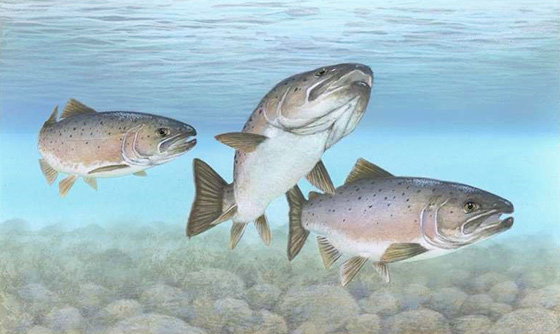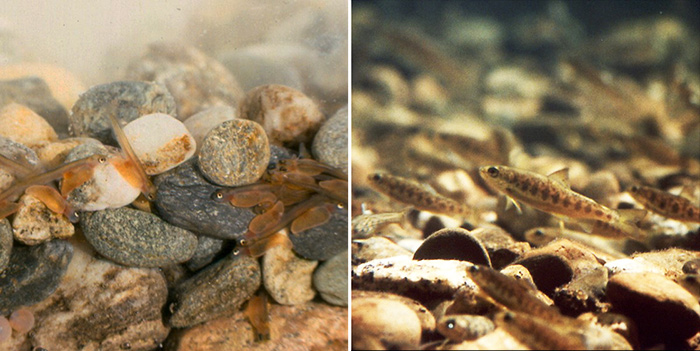
Within a tiny salmon egg, molecules of magnetite are already gathering.
Once the egg hatches and the salmon begins to grow, it moves downriver, eating larger prey, taking in iron from its environment and its food, to synthesize more magnetite to store in its body—particularly in the sinus bones within its skull.
Once it’s large enough to enter the ocean, its scales change from green and brown to the silver and gray of the open sea.
The magnetite in its nose begins to line up into chains that can detect and respond to the magnetic fields of the Earth.
The salmon is developing its magnetoreception.
In the ocean, it feeds on fish and krill, ingesting more iron, storing more magnetite, traveling thousands of miles—up to 18 miles a day—over the next few years, guided in the dark waters by its three-dimensional magnetoreception, sensing not only direction but intensity and inclination of the magnetic field.
When it’s time to return to its home river, magnetoreception is aided by another sense in its nose: smell.
The salmon can detect just a few parts per million of its birth river in ocean currents and follow them home. Once there, it will mate and die.
Nutrients and minerals from its body will return to the stream to nourish future salmon, who will make their own magnetite for their own magnetoreception, to guide their own miraculous journey, handed down across thousands of generations.
Background
Synopsis: Salmon are a natural wonder—born with both an inner map and a 3D compass, an extraordinary sense of smell, and possibly other navigational capabilities. They live an extraordinary life cycle, undergoing changes that enable them to shift from the fresh water of their birth into the sea and then return to fresh water to spawn the next generation. They are able to navigate in three dimensions using magnetoreception and can find their way back to the stream of their birth using a combination of their senses. Salmon are able to navigate without any previous learning, so they must be using an inherited skill.
- In the late 1970s, scientists discovered an iron-rich magnetic material called magnetite (Fe3O4) that existed as fine grains within the bodies of honeybees and homing pigeons. In the 1980’s, researchers located oriented magnetite chains in the olfactory region of both Chinook and Sockeye salmon that continue to grow during the life cycle of the fish, providing them with the sixth sense of magnetoreception—their compass.
- The salmon life cycle starts in the gravel of the upper reaches of freshwater streams.
- Salmon start their lives as pea-sized eggs in nests called redds. Spawning occurs at different times for different species, from July to February.
- In 2–6 months, the eggs hatch into sac fry equipped with the remainder of their yolk in a “mini-lunchbox” called a sac. They hide in the gravel of their redd while there is still yolk to eat; after that, the fry have to leave the gravel to find other food like plankton.

Credit: E. Peter Steenstra/U.S. Fish and Wildlife Service, Northeast Region (public domain)
- Researchers have recently determined that even these tiny fry have 3D magnetoreception capabilities; they make their way up out of the gravel using their geomagnetic sense.
- Previous studies showed how temperature, light, and water current impacted the emergence of the fry. But even when these cues are unavailable, the fry still make their way up to the streambed.
- The recent experiment exposed one group of fry to a magnetic field that was inverted—the magnetic field lines pointed upward instead of downward. In comparison to fry tested under normal magnetic conditions, these fish did not move as far upward from the gravel, suggesting that the fish are using magnetic cues to help guide their up/down movements.
- Once the salmon have found their way into the streambed, they need cool, oxygen-rich water to survive and must avoid predators as they mature into camouflaged juveniles called parr.
- They may remain in the juvenile stage from a few months to 3 years, feeding on small invertebrates and running in schools.
- When they are ready to migrate out to sea, the salmon move toward the brackish water of estuaries and undergo amazing changes to their physiology that prepare them for life in salt water.
- As parr become smolt, they develop silvery scales to camouflage them in the ocean.
- The 6–8 inch (15–20 cm) long smolt are ready to head out to sea in late spring.
- They may form schools during their first year in the ocean.
- As adult fish in the open ocean, salmon may migrate thousands of miles from their spawning grounds, accumulating important ocean nutrients that they ultimately deliver back to their freshwater streams of origin.
- Salmon travel about 18 miles per day and may migrate over 3,000 miles from their home stream in search of food.
- Salmon have demonstrated a remarkable sense of smell that helps them find their way back to their streams of origin.
- Just before a salmon leaves its home stream, the memory and smell centers in its brain grow rapidly.
- They can follow a scent trail as faint as just one drop of their home-stream water in 250 gallons of seawater.
- Salmon also use magnetic orientation to find their way out to traditional open-ocean feeding grounds and then back to their streams of origin.
- Using an array of coiled wires, researchers are capable of precisely manipulating the magnetic field of animals in a lab setting. This technique has been used to perform “magnetic displacements,” where the magnetic field around an animal is changed to mimic a distant location, although the animal remains in the same location.
- Juvenile Pacific salmon and trout that had no migratory experience were “magnetically displaced” to magnetic fields that exist north or south of their range in the Pacific Ocean. Fish in the group exposed to a northern field oriented southward, and fish in the southern field oriented northward. Those not exposed to change in magnetic conditions did not have a directional preference.
- Further experiments indicated that these salmon used both intensity and inclination of the magnetic field to make their orientation decisions for navigation.
- These experiments were also carried out on a group of salmon that had been translocated from Maine to an Oregon recreational fishery; their ancestors had been landlocked for perhaps the past 10,000 years. Despite no recent evolutionary history of ocean migration and the transcontinental displacement, these fish oriented similarly when exposed to magnetic fields that exist in the Pacific Ocean.
- These most recent results raise the question of how salmon (and other animals that use magnetic cues for positional information like sea turtles, eels, and birds) pair magnetic and geographic information.
- Once salmon make their way back from the ocean depths to their freshwater home, they go through major physiological changes again, changing color and shape.
- Their bodies change from silver to brown, green, or red.
- The males may develop humped backs and hooked snouts with elongated teeth to defend their spawning territory and attract females.
- The fish stop feeding in fresh water, instead living off the energy stored during their ocean voyages.
- After spawning, the adult salmon die and their decaying bodies provide ocean nutrients to the upland streams, continuing the fertile cycle.

